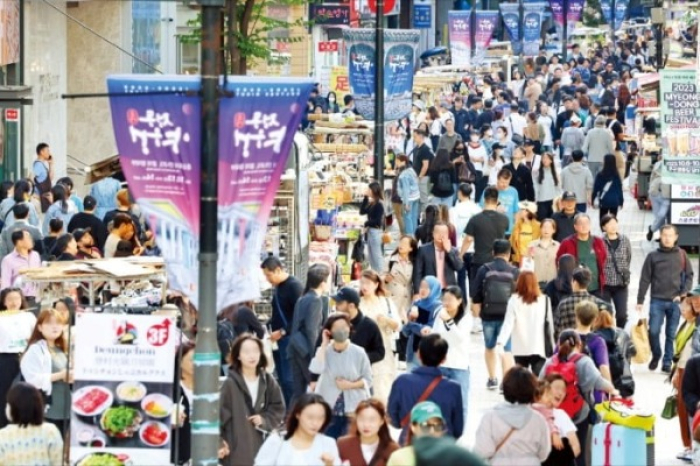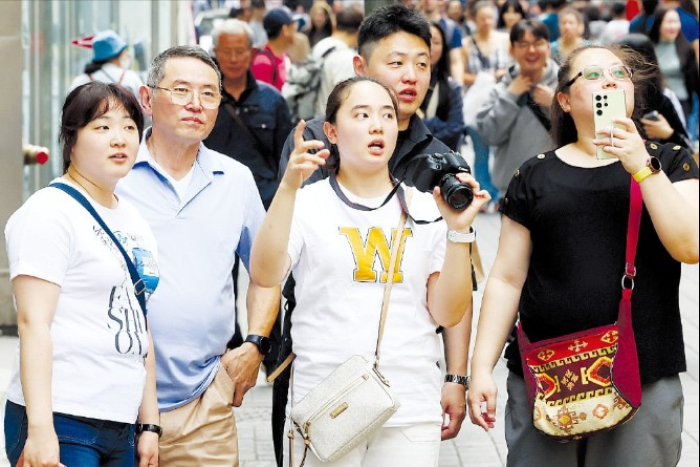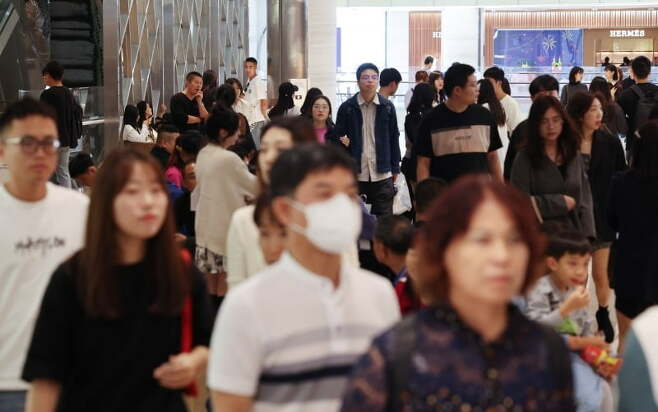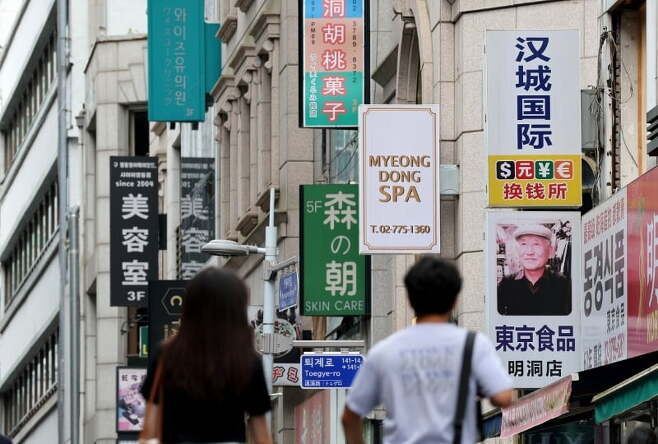S.Korea sees rise in young, independent Chinese tourists
Chinese MZers boost digital payments at convenience stores in Korea; duty-free revenue declines as group tours slow
By Oct 15, 2023 (Gmt+09:00)
LG Chem to sell water filter business to Glenwood PE for $692 million


Kyobo Life poised to buy Japan’s SBI Group-owned savings bank


KT&G eyes overseas M&A after rejecting activist fund's offer


StockX in merger talks with Naver’s online reseller Kream


Mirae Asset to be named Korea Post’s core real estate fund operator



South Korea is welcoming a growing number of Chinese tourists since China lifted a ban on group tours to its neighboring country on Aug. 10 after more than six years.
Compared with the pre-pandemic era, more Chinese are opting for independent travel rather than group tours and are spending less on duty-free shopping. A greater number of younger Chinese are visiting, boosting digital transactions at Korea’s convenience stores, tourism industry sources say.
The number of Chinese travelers to Korea in August reached 259,659, up 15.5% from July. The August figure is 10.4 times the January figure, according to state-backed Korea Tourism Organization (KTO) data on Friday.
The increase in Chinese visitors to Korea continued into September, thanks to China’s National Day holidays that stretched from Sept. 29 to Oct. 6, industry sources say.
The KTO estimates that more than 75,000 Chinese tourists arrived in Korea during their National Day holidays alone.
During that period, 17,698 Chinese tourists visited Korea's southern resort island of Jeju, a favorite destination. That number is 77.9% of the same holiday period in 2019, before the COVID-19 breakout, according to the Jeju Tourism Association.

DECLINE IN GROUP TOURS
Lately, Chinese tourists to Korea have exhibited different travel trends compared with the pre-pandemic era.
One major change is that more are traveling independently rather than on group tours.
Four passenger ships operating between China and Korea’s Incheon — used mainly by group tours — resumed operations on Aug. 12. Their average occupancy rate as of Sept. 25 was less than 20%, Incheon Port Authority data showed.
One ship with a capacity of 660 passengers operated 37 sailings between Incheon and Qingdao, China, during the period. Its highest occupancy rate was just 18%.
Meanwhile, 931,272 Chinese passengers flew air routes between Korea and China in August, reaching 45% the level of August 2016, before China blocked group tours to Korea in retaliation for Seoul’s deployment of the US Terminal High Altitude Area Defense System (THAAD).
Korea’s duty-free and travel retail market, whose key customers have long been Chinese group tourists, saw a decline in revenue. The duty-free industry posted 1.14 trillion won ($843.5 million) in revenue in August, down 27.6% from the year-earlier period, according to the Korea Duty Free Association.

INCREASE IN YOUNGER VISITORS
Visitors from China’s younger generations, who often travel on a budget and are comfortable with mobile payment, are increasing, industry sources say.
CU, BGF Retail Co.'s convenience store unit, saw cross-border payments by customers in September increase by 70.7% from the same month in 2019, before the pandemic outbreak.
Chinese digital payment systems like Alipay, WeChat Pay and UnionPay make up 92% of total cross-border transactions at CU stores.
The younger visitors — Chinese millennials or Gen Zers — are reviving Garosu-gil in Gangnam District and Seongsu near Seoul Forest, whereas Myeongdong and Dongdaemun were areas traditionally popular with Chinese tourists.
“Garosu-gil is a great place to take photos because there are many flagship stores of popular brands and beautiful cafes. Also, it’s easier to walk around there than in Myeongdong, which is often crowded with foreign tourists,” said Sun Lin, 30, a Chinese visitor.

MORE INDEPENDENT TOURISTS EXPECTED
Group tours from China to Korea will continue to slow, industry sources say.
Seoul’s deployment of THAAD and COVID-19 have led to the closure of many Korean travel agencies that catered exclusively to Chinese tourists. The numbers of tour bus drivers and Chinese-speaking travel guides have also plummeted, sources said.
“Group tours from China to Korea are often canceled because of price. Many travel agencies in China ask their Korean partners for prices similar to the pre-pandemic levels, despite high inflation in Korea,” one travel industry source said.
Korea will continue to see an upward trend in the number of independent travelers given the convenience of finding travel information on smartphones, while translation apps have helped lowered language barriers.
“The more people travel abroad, the more they prefer independent travel. The duty-free industry should adapt their sales strategies to such trends,” said Lee Hoon, a professor at Hanyang University's Tourism Department.
Write to Young Chan Song at 0full@hankyung.com
Jihyun Kim edited this article.
-
 RetailKorea’s tourism industry pins high hopes on return of Chinese big spenders
RetailKorea’s tourism industry pins high hopes on return of Chinese big spendersAug 10, 2023 (Gmt+09:00)
3 Min read -
 AirlinesAir travel from Korea roars back to everywhere, except China
AirlinesAir travel from Korea roars back to everywhere, except ChinaAug 04, 2023 (Gmt+09:00)
3 Min read -

-
 Travel & LeisureVietnamese tourists top in card spending in Korea in 2022
Travel & LeisureVietnamese tourists top in card spending in Korea in 2022May 03, 2023 (Gmt+09:00)
3 Min read -
 Travel & LeisureTourist arrival gap between S.Korea, Japan widens sharply
Travel & LeisureTourist arrival gap between S.Korea, Japan widens sharplyMar 10, 2023 (Gmt+09:00)
1 Min read


